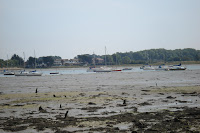




Happy second birthday to this blog! To mark the occasion I am kicking off a month of top fives – children’s authors list their personal playlists for all sorts of subjects.
I’ve chosen my favourite Top Five school stories inspired in part by the brilliant recent time travel story Beswitched by Kate Saunders, in which 21st century Flora finds herself at a 1930s boarding school. It's funny, clever and there's a lot of feminism smuggled in there too.
A good school story makes you feel as though you're in the classroom with the characters. Many are set in boarding schools - an enclosed society, perfect for authors, although I did find myself wondering why there was no series that I could think of set in a modern comprehensive. Here's my top five, in reverse order.
5 Yoko and Friends – Rosemary Edwards. Some people find the kittens and other creatures in Rosemary Edwards' picture books too cutesy, I just love the very human tales of classroom life that lie behind the fluffy exteriors. Poor Yoko, for example, is mocked by her schoolmates because her lunch is traditional Japanese sushi. ‘Raw fish, yuk!’ they say. Well-meaning adult attempts to help are doomed to failure - an international lunch ends with everything eaten except Yoko’s spurned sushi. But help is at hand, thanks to a very hungry classmate with an adventurous palate.
4 Growing up in the 1970s I loved the Chalet School series by Elinor Brent Dyer, already classics written 40 years before. A boarding school in Switzerland, where the girls come from all over Europe and speak French one day and German the next. Adventures that involve skiing and Nazis. A rolling narrative, through book after book, in which an awkward spiky outsider learns to become a true Chalet girl. It’s easy to mock these stories now- and true, it does get a bit silly when everyone begins having multiple sets of triplets – but their vision of international co-operation and the information they gave about mainland Europe was quite inspirational, growing up in monochrome 1970s England. When my children attended an international school, I was often reminded of the good old Chalet School.
3 I have no doubt that much of the success of J K Rowling’s Harry Potter series is down to Hogwarts, her fabulous pastiche of almost every English boarding school story trope. Eccentric teachers, dormitories, letters from home, a kind but stern matron, a fatherly head teacher, priggish prefects, rabid inter-house competition - it’s all there, with the magical elements woven in.
2 The thinking reader’s school series, Antonia Forest’s books about Kingscote School (Autumn Term, End of Term, The Attic Term and Cricket Term) and the related books about the Marlow family are the best examples of the English boarding school genre I know. Every character is nuanced and rounded, and the author is equally confident with the details of boarding school life - the cricket matches, school plays, scholarships and with huge themes like bereavement and religion. I must have read each one hundreds of times, and every reading is just as satisfying as the first.
1. But my absolute favourite school story is not about an English school at all. Masha by Mara Kay is set at Smolni, the famous St Petersburg girls’ school set up by Catherine the Great in the eighteenth century for noble Russian girls. Masha, aged 9, wins a scholarship and that means leaving her mother and home for nine long years to travel to St Petersburg, far, far away.
Poor Masha’s loneliness and longing for home, amid girls who tease her for her unsophisticated country ways is heartbreaking, and every detail of school life in early nineteenth century Russia is fascinating. At Smolni the girls had their hair shaved off when they arrived. For three years they were in the Brown form, followed by the Blue and then White, named for the colour of their uniforms.
One of my favourite scenes comes the first time Masha sees a Christmas tree: ‘something green and tall, ablaze with candles, smelling with pine, resin and melted wax.’ Masha, overcome with amazement, falls to her knees in front of the tree. ‘Fraulein Knappe exclaimed, ‘Fredericks!’ The Browns stopped short, falling over eachother to get a better look at Masha. The Blues and Whites who entered the ballroom, kept asking; ‘What is it? What has happened?’
It was Madmoiselle Neighardt, appearing from nowhere, who jerked Masha up, not too gently. ‘You really should teach that child more restraint, Mademoiselle,’ she snapped, and was going to say something more but at the sight of the French woman’s elaborate coiffure words seemed to fail her.'
Masha and the sequel, The Youngest Lady in Waiting are inexplicably out of print - and copies are now highly sought by collectors. The hardback that my parents bought for me on my tenth birthday (after I'd borrowed Masha from the library week after week) must be worth about £300 by now. But I’d never sell it. My favourite school story is actually my favourite book of all.



























